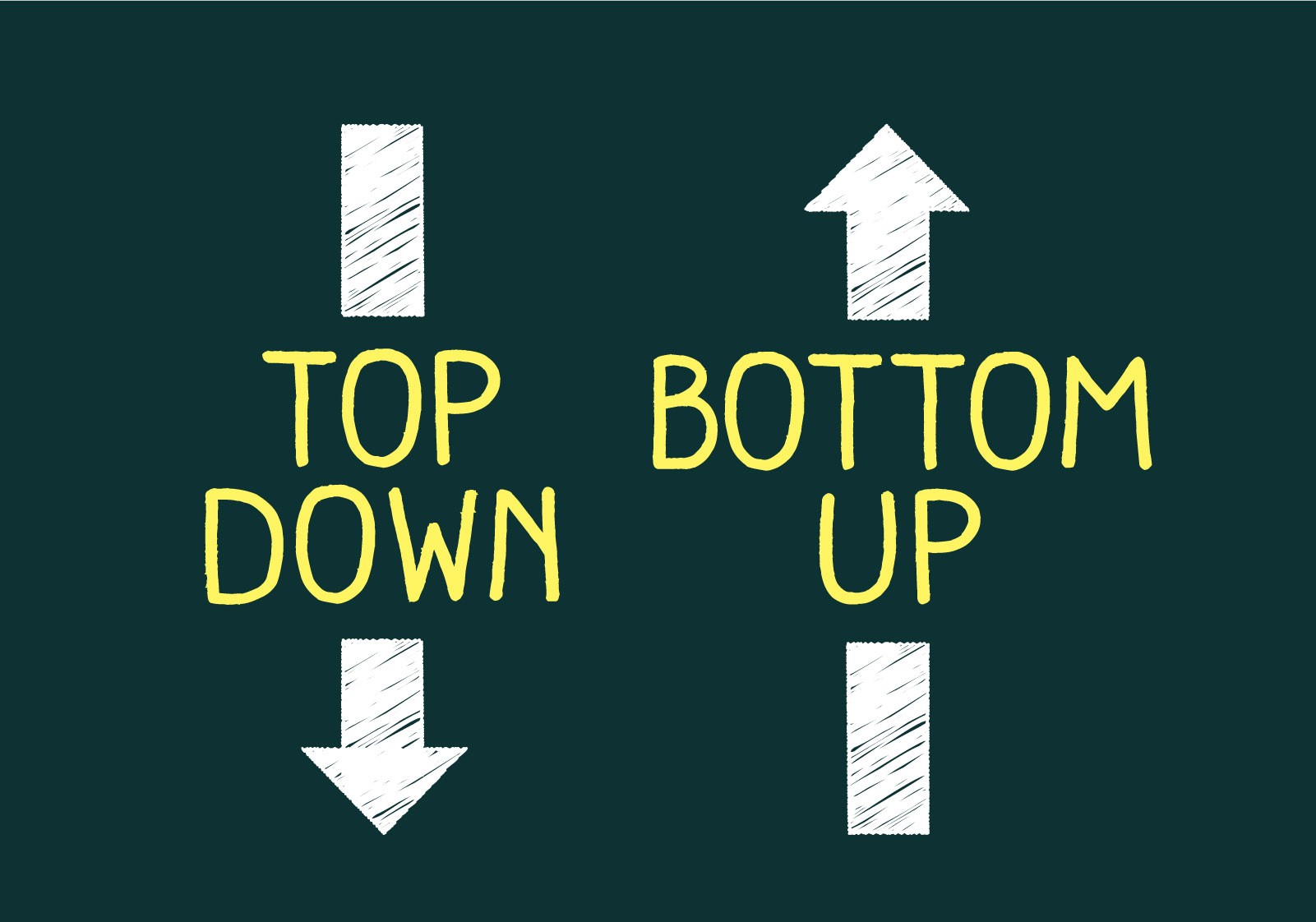What is the Best Investing Approach? Bottom-Up vs. Top-Down Investing

There are many variables at play when you invest your money. Market trends, price movements, the nation's economy, past returns, and other factors can help you select the right investment product for your needs. These factors, along with several more, can help you understand how a particular investment will work and whether or not it is ideal for your time horizon and risk appetite. In technical terms, this is known as investment analysis. This is defined as the process of using multiple valuations to understand and analyze the market, as well as different industries, sectors, and companies. Most commonly, financial experts and investors use factors like past returns, yield potential, market sentiments, etc., to compare different investment options and accordingly invest their money.
For instance, if you are thinking of investing in a mutual fund, you can carry out an investment analysis of your short-listed mutual fund schemes. The investment analysis can entail comparing the returns of the chosen scheme with its benchmark. You can also compare similar schemes to note the difference in their returns, expense ratios, exit loads, portfolios and asset allocation, management style, beta, standard deviation, Sharpe ratios, and more.
There are different investment analysis strategies, such as technical analysis, fundamental analysis, bottom-up investing strategy, and top-down investing approach. You can conduct investment analysis on your own. But if things seem challenging, you can also contact a financial advisor and ask for help. However, regardless of your choice, you must consider completing the activity as it can help you make better investment decisions. The needs and preferences of all investors differ. Therefore, a thorough analysis is vital.
This article discusses and compares two investing analysis strategies - top-down vs bottom-up investing. Read on to find out which one is better suited for your requirements.
1. Top-down approach to investing:
As the name suggests, a top-down investing approach moves from the top and goes down to the bottom of the ladder. This means, when analyzing stocks, mutual funds, etc., for investments, you would start your way from macroeconomic factors to understand how your investment will likely perform when influenced by economy-level factors. You can accordingly pick investment options you think will benefit from these external stimuli. You can then move down to more minor variables like companies, sectors, and industries.
Here are some things you would typically pay attention to when conducting the top-down investing strategy:
- The country's Gross Domestic Product (GDP)
- The Federal Reserve Bank's monetary policy
- Interest rate trends
- Bond prices
- The country's unemployment rate
- The country's inflation
- Business cycles, etc.
- The performance of a particular industry and sector compared to competitors and previous years.
Investors mainly use the top-down investing strategy for mutual funds and exchange-traded funds (ETFs). However, it can also be used to analyze commodities, stocks, bonds, etc. The common notion is that if a sector is doing well, given the macroeconomic conditions in the country, the individual stocks will perform well too. For instance, if the interest rates drop, people are more likely to buy houses as loans become more pocket-friendly. This can give more business to the real estate and homebuilding industry, making it a perfect time to invest in the stocks of these sectors. Likewise, if oil prices rise, it can benefit oil companies but not other companies who depend on oil for transportation and production, as the costs for these would increase and affect their profits. So, you can consider the impact of the rise in the price of oil on different sectors and then take a call.
2. Bottom-up investing strategy:
The bottom-up investing strategy is the opposite of the top-down approach. It starts from the bottom by analyzing individual companies and stocks and then moves up to macroeconomic aspects. When conducting the bottom-up strategy, investors study the company's performance, its core principles and fundamentals, demand for a particular product, etc., and pick a stock for investment based on the results. Contrary to top down investors, bottom-down investors do not study how the whole sector gets affected. Instead, they pay attention to select companies and their stocks. For instance, if the demand for vegan meat is on the rise, top-down investors may consider investing in vegan meat-producing companies. However, a bottom-down investor will study the performance of a specific company and may or may not invest in the company's stocks depending on the company's past returns and performance.
Bottom-down investors are not concerned with the performance of the entire industry or market and solely focus on individual businesses. Therefore, this strategy is primarily helpful for stocks rather than mutual funds or ETFs.
Here are some things you can pay attention to when conducting the bottom-up investing strategy:
- The company's business fundamentals
- The company's product and service portfolio
- The company's leadership and history
- Financial ratios like the debt-to-equity ratio, price-to-earnings (P/E) ratio, price-to-sales ratio, etc.
- The company's balance sheet, cash flow, return on equity, etc.,
- The company's liabilities and losses
- Market opinion and speculation
Overall, investors following the bottom-up investment strategy look for specific stocks they think will do well. They are not looking to invest in a sector. They are looking to invest in a company. As a result, a bottom-down investor will tend to buy specific stocks more often than funds. This can be time-consuming, as every company differs from the next. Constructing a portfolio of different stocks will likely take a lot of time and effort. However, the risk involved can be cut down significantly, as investors are more sure of their decisions.
Bottom-up investing vs top-down investing – which is better and why?
There is no right or wrong approach as both strategies can be used by different investors and for various purposes. Ideally, the top-down investing strategy is more commonly employed by new or relatively less experienced investors. The top-down approach can require detailed research on a number of parameters. Hence, new investors may find this overwhelming to conduct. On the other hand, the bottom-up investment strategy can be relatively less complex as you only concentrate on one company. By narrowing down your research, you are able to simplify matters.
Having said that, the final decision to choose either of the two is an individual choice and most likely depends on the type of investment, the investment horizon, goal, etc. Moreover, you do not have to pick one and stick to it necessarily. You can choose a combination of both strategies and invest in multiple instruments. Not only will this help you follow a comprehensive approach, but it will also diversify your investment portfolio and ultimately improve your returns and lower risk. For instance, if you are thinking of investing in international stocks, you can choose a company and use the bottom-up investing strategy to analyze its business model, profit and loss, product portfolio, etc. At the same time, you can also look at the country's economy, tax policies, inflation rate, interest rate trends, and more to get an idea of the macroeconomic factors that could impact your investment returns. If the country where the company operates is expecting a national-level election, the company's stock prices may fluctuate. Likewise, wars, pandemics, social factors, natural calamities, etc., can also affect the company's stocks. Together, both strategies can help you make a well-informed investment choice.
There may also be some limitations of the bottom-up and top-down investing methods, too. For instance, a lot of financial experts feel the former is not an optimal measure of performance at market peaks and troughs. The results of the bottom-up investment analysis at peaks may be extra enthusiastic, while in troughs, a bit too cynical. Some investors and experts also believe that the top-down investment analysis may focus on the past, which may not be a sound indicator of the future. Moreover, it may not account for unpredictability and unlikely situations that may crop up in the future.
The important thing to note here is that using both strategies can take some time and experience. If you are new at investing, you may find them hard initially. However, over time, you can improve your analyzing skills. In addition to this, you can also consider hiring a financial advisor. Professionals like financial advisors have relevant know-how of the market as well as enough knowledge of how to analyze companies. You can leverage their understanding and use it to make investment decisions that align with your specific financial goals. Hiring a financial advisor can also help you in other ways like budgeting, tax planning, savings, and more. All of this ultimately enables you to get to your goals faster and eliminate errors along the way.
To summarize
The question of bottom-up investing vs top-down investing strategy makes for an engaging debate, but you do not necessarily have to choose one over the other. In reality, understanding how each of these works can be helpful in creating a diversified, low-risk portfolio that can stand the test of time and be least impacted by market forces and other factors. Having said that, it can take some time to master the two techniques. While time and practice are the best ways to achieve this, you can also consider hiring a professional financial advisor in your area for assistance, so you can make rational investment choices that benefit you in the long run.
If you are looking for guidance on different investment strategies and wish to find out which things to look out for when conducting an analysis of an investment, use the free advisor match service. Get matched with 1-3 vetted financial advisors that can help you with your unique financial needs and goals.







.jpg)












.jpg)






.jpg)


.jpg)


.jpg)














.jpg)




.jpg)






.jpg)

.jpg)







.jpg)

.jpg)






.jpg)




.jpg)
.jpg)

.jpg)



.jpg)





.jpg)
.png)
.jpg)


.jpg)


.jpg)




.jpg)

.jpg)


.jpg)
.jpg)
.jpg)
.jpg)
.jpg)

.jpg)



.jpg)




.jpg)
.jpg)


.jpg)
.jpg)
.jpg)
.jpg)
.jpg)

.jpg)




.jpg)
.jpg)


.jpg)
.jpg)
.jpg)
.jpg)

.jpg)

.jpg)













.jpg)


.jpg)


.jpg)




.jpg)











.jpg)



